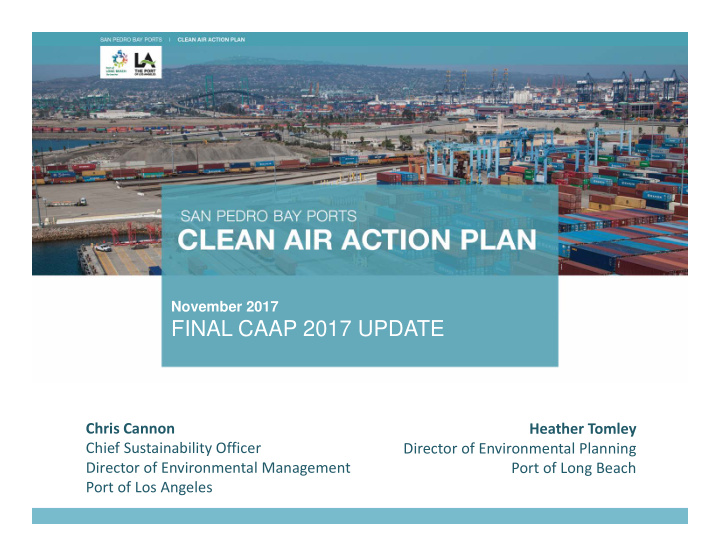



November 2017 FINAL CAAP 2017 UPDATE Chris Cannon Heather Tomley Chief Sustainability Officer Director of Environmental Planning Director of Environmental Management Port of Long Beach Port of Los Angeles
San Pedro Bay Ports Air Quality Context for 2017 CAAP Update 2023 59 % 2023 77 % 2023 93 % www.cleanairactionplan.org
2017 CAAP Update – Background and Purpose • Build on successes and plan for the future • Cleanest Port complex in the world • Leaders in strategies to reduce environmental impacts • Ports must be green in order to continue to grow • Need to balance environmental stewardship, economic competiveness, and jobs • Must continue to reduce pollutants and health risk www.cleanairactionplan.org
2017 CAAP Update – Background and Purpose • New danger from Climate Change • Must commit to reduce greenhouse gases • Importance of zero emission technologies, as emphasized by Mayors’ declaration • CAAP is a planning document • Sets framework and guidelines • Details will be developed as part of CAAP implementation process www.cleanairactionplan.org
New CAAP Focus on Greenhouse Gases 2016 2030 40% 2050 80%
2017 CAAP Update Schedule Final CAAP Public Comment and Over 70 Stakeholder Meetings 2017 2015 - Ongoing Joint Board Meeting 11/2/17 Draft Discussion Draft CAAP Joint Boards of Document Harbor 2017 Released 11/17/16 Commissioners to Released 7/19/17 consider approval Public Public Public Workshop Workshop Workshop 10/2015 1/2017 8/2017 www.cleanairactionplan.org
Recurring Comment Themes carbon footprint accountability feasibility assessments stakeholder process interim milestones infrastructure emission reductions zero-emissions workforce CLI MATE CHANGE community health economic competitiveness funding near-zero emissions www.cleanairactionplan.org
Guiding Principles • Expeditiously reduce air emissions and associated health risk • Remain economically competitive and maintain our market position • Support our vibrant workforce • Continue to develop and foster strong partnerships with all stakeholders • CAAP implementation process must be transparent and responsive to input www.cleanairactionplan.org
2017 CAAP Update Strategies Overview
Ocean-Going Vessels • Capture up to 100% of vessel at-berth emissions by 2030 • Modify Vessel Speed Reduction Program to maximize participation to 40 nm • Incentivize energy-efficiency improvements and use of cleaner technologies • Impose differential rate system to incentivize newer, cleaner vessels
Heavy-Duty Trucks • Transition trucks to near-zero in the near-term and ultimately zero emissions by 2035 • Implement Port Truck Reservation System
Terminal Equipment • Transition terminal equipment to zero emissions by 2030 • Establish a terminal equipment idling reduction program • Develop charging standards for electric terminal equipment
Additional 2017 CAAP Update Strategies • Incentivize harbor craft repowers to Tier 3 and Tier 4 • Expand use of on-dock rail • Develop a Green Terminal Program • Identify and implement supply chain efficiencies • Develop and implement energy strategies and supporting infrastructure www.cleanairactionplan.org
Updates and Clarifications Response to Comments on the Draft
Feasibility Assessments • Technical Viability • Operational Feasibility • Availability of Supporting Infrastructure and Fuels • Economic Considerations • Commercial Availability www.cleanairactionplan.org
Cargo Handling Equipment • Goal of zero emission cargo handling equipment by 2030 • Participate in development of CARB’s regulation to achieve up to 100% ZE for CHE by 2030 • Conduct feasibility assessments starting in 2018 and updating every three years www.cleanairactionplan.org
Cargo Handling Equipment • Terminals to submit an equipment inventory and 10-year procurement schedule for new equipment starting January 1, 2019. • Beginning in 2020, new purchases must be zero- emission, or best available if zero-emission is not yet feasible, as determined by the Feasibility Assessment. • Accelerate deployment of near-zero and zero-emission equipment through leases and grants. www.cleanairactionplan.org
Previous Clean Trucks Program Timeline 2018 2023 2035 New Registration New Registration Goal for all Requirement for Requirement for trucks to be ZE MY 2014+ NZE Modify Rate with Exemptions only I nitiate Rate for ZE with Exemptions for NZE & ZE www.cleanairactionplan.org
New Clean Trucks Program Timeline 2018 2020 2023 2035 New Registration New Registration Goal for all Requirement for Requirement for trucks to be ZE MY 2014+ NZE Modify Rate with Exemptions only I nitiate Rate for ZE with Exemptions for NZE & ZE www.cleanairactionplan.org
Additional Key Comments and Clarifications • Economic Competitiveness • Truck Driver Conditions and Financing • Implementation Milestones • Transparency and Reporting www.cleanairactionplan.org
Next Steps • We’re at the starting point • Near-Term Actions • CAAP Implementation Advisory Workgroup • Technology Demonstrations • Feasibility Assessments • Clean Trucks Program • Port Truck Reservation System • Terminal Equipment www.cleanairactionplan.org
Next Steps • Funding Advocacy • Education and Engagement • Grant Opportunities • U.S. Environmental Protection Agency • California Air Resources Board • California Energy Commission • South Coast Air Quality Management District www.cleanairactionplan.org
Joint Meeting of the Board of Harbor Commissioners www.cleanairactionplan.org
Recommend
More recommend